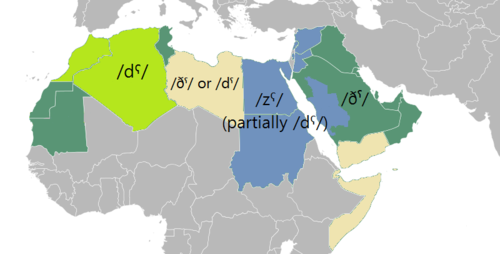| Ẓāʾ | |
|---|---|
| Arabic | ظ |
| Phonemic representation | ðˤ~zˤ, dˤ |
| Position in alphabet | 27 |
| Numerical value | 900 |
| Alphabetic derivatives of the Phoenician | |
| Ẓāʾ | |
|---|---|
| ظ | |
| Usage | |
| Writing system | Arabic script |
| Type | Abjad |
| Language of origin | Arabic language |
| Phonetic usage | ðˤ~zˤ, dˤ |
| Alphabetical position | 17 |
| History | |
| Development |
|
| Other | |
| Writing direction | Right-to-left |
| Arabic alphabet |
|---|
|
Arabic script |
Ẓāʾ, or ḏ̣āʾ (ظ), is one of the six letters the Arabic alphabet added to the twenty-two inherited from the Phoenician alphabet (the others being ṯāʾ, ḫāʾ, ḏāl, ḍād, ġayn). In name and shape, it is a variant of ṭāʾ. Its numerical value is 900 (see Abjad numerals).
Ẓāʾ ظَاءْ does not change its shape depending on its position in the word:
| Position in word | Isolated | Final | Medial | Initial |
|---|---|---|---|---|
| Glyph form: (Help) |
ظ | ـظ | ـظـ | ظـ |
YouTube Encyclopedic
-
1/4Views:20 06414 050105 7681 095
-
تعلم الحروف العربية حرف الظاء | learn Arabic Alphabet (letter ẓāʾ )
-
Imagine Being Very Famous In Another Country And Having No Idea About It
-
South Africa is considering to sell powdered rhino horn to Asian Tourists | News@9 Shorts | UPSC
-
Did Ramzan Really Come From Ramadan? [The Surprising Truth]
Transcription
Pronunciation

In Classical Arabic, it represents a velarized voiced dental fricative [ðˠ], and in Modern Standard Arabic, it can also be a pharyngealized voiced dental [ðˤ] or alveolar [zˤ] fricative.
In most Arabic vernaculars ظ ẓāʾ and ض ḍād merged quite early.[1] The outcome depends on the dialect. In those varieties (such as Egyptian, Levantine and Hejazi), where the dental fricatives /θ/ and /ð/ are merged with the dental stops /t/ and /d/, ẓādʾ is pronounced /dˤ/ or /zˤ/ depending on the word; e.g. ظِل is pronounced /dˤɪl/ but ظاهِر is pronounced /zˤaːhɪr/, In loanwords from Classical Arabic ẓāʾ is often /zˤ/, e.g. Egyptian ʿaẓīm (< Classical عظيم ʿaḏ̣īm) "great".[1][2][3]
In the varieties (such as Bedouin and Iraqi), where the dental fricatives are preserved, both ḍād and ẓāʾ are pronounced /ðˤ/.[1][2][4][5] However, there are dialects in South Arabia and in Mauritania where both the letters are kept different but not consistently.[1]
A "de-emphaticized" pronunciation of both letters in the form of the plain /z/ entered into other non-Arabic languages such as Persian, Urdu, Turkish.[1] However, there do exist Arabic borrowings into Ibero-Romance languages as well as Hausa and Malay, where ḍād and ẓāʾ are differentiated.[1]
Statistics
Ẓāʾ is the rarest phoneme of the Arabic language. Out of 2,967 triliteral roots listed by Hans Wehr in his 1952 dictionary, only 42 (1.4%) contain ظ.[6]
In other Semitic languages
In some reconstructions of Proto-Semitic phonology, there is an emphatic interdental fricative, ṱ ([θˤ] or [ðˤ]), featuring as the direct ancestor of Arabic ẓādʾ, while it merged with ṣ in most other Semitic languages, although the South Arabian alphabet retained a symbol for ẓ.
In relation with Hebrew
Often, words that have ظ ẓāʾ, ص ṣād, and ض ḍād in Arabic have cognates with צ tsadi in Hebrew.
- Examples
- ظ ẓāʾ: the word for "thirst" in Classical Arabic is ظمأ ẓamaʾ and צמא tsama in Hebrew.
- ص ṣād: the word for "Egypt" in Classical Arabic is مصر miṣr and מצרים mitsrayim in Hebrew.
- ض ḍād: the word for "egg" in Classical Arabic is بيضة bayḍah and ביצה betsah in Hebrew.
When representing this sound in transliteration of Arabic into Hebrew, it is written as ט׳ tet and a geresh or with a normal ז zayin.
Character encodings
| Preview | ظ | |
|---|---|---|
| Unicode name | ARABIC LETTER ZAD | |
| Encodings | decimal | hex |
| Unicode | 1592 | U+0638 |
| UTF-8 | 216 184 | D8 B8 |
| Numeric character reference | ظ |
ظ |
See also
References
- ^ a b c d e f Versteegh, Kees (1999). "Loanwords from Arabic and the merger of ḍ/ḏ̣". In Arazi, Albert; Sadan, Joseph; Wasserstein, David J. (eds.). Compilation and Creation in Adab and Luġa: Studies in Memory of Naphtali Kinberg (1948–1997). pp. 273–286. ISBN 9781575060453.
- ^ a b Versteegh, Kees (2000). "Treatise on the pronunciation of the ḍād". In Kinberg, Leah; Versteegh, Kees (eds.). Studies in the Linguistic Structure of Classical Arabic. Brill. pp. 197–199. ISBN 9004117652.
- ^ Retsö, Jan (2012). "Classical Arabic". In Weninger, Stefan (ed.). The Semitic Languages: An International Handbook. Walter de Gruyter. pp. 785–786. ISBN 978-3-11-025158-6.
- ^ Ferguson, Charles (1959). "The Arabic koine". Language. 35 (4): 630. doi:10.2307/410601. JSTOR 410601.
- ^ Ferguson, Charles Albert (1997) [1959]. "The Arabic koine". In Belnap, R. Kirk; Haeri, Niloofar (eds.). Structuralist studies in Arabic linguistics: Charles A. Ferguson's papers, 1954–1994. Brill. pp. 67–68. ISBN 9004105115.
- ^ Wehr, Hans (1952). Arabisches Wörterbuch für die Schriftsprache der Gegenwart. [page needed]
